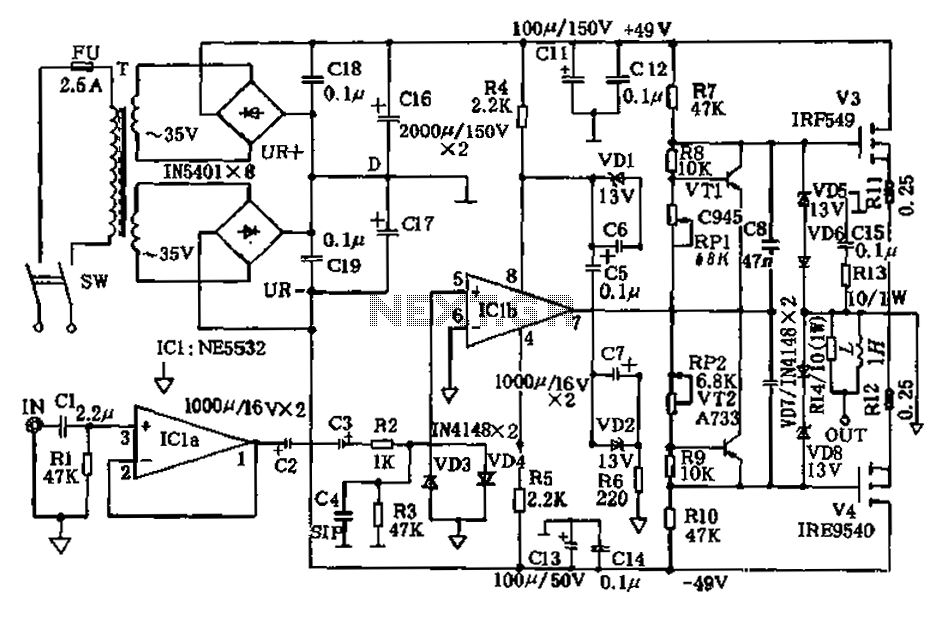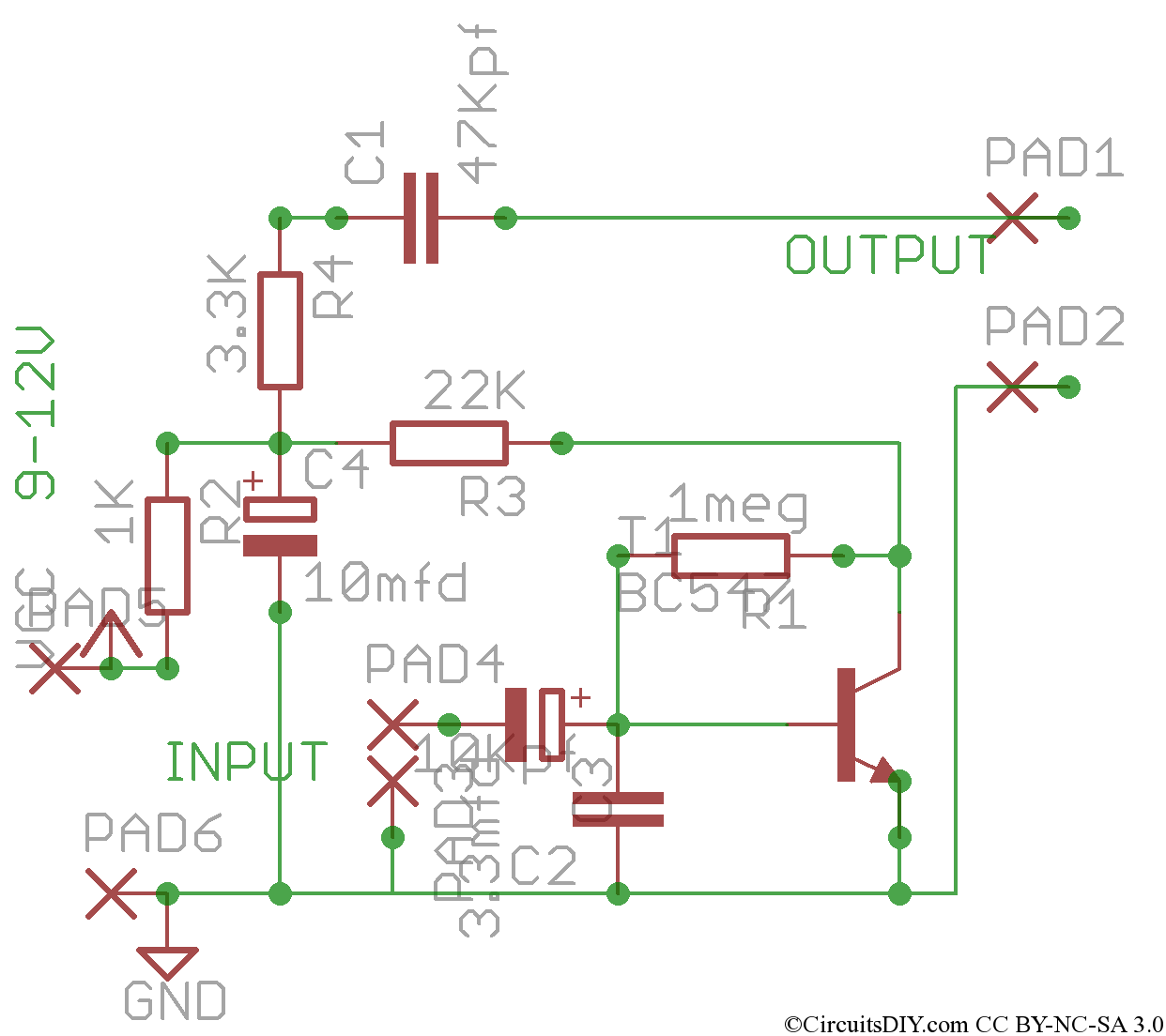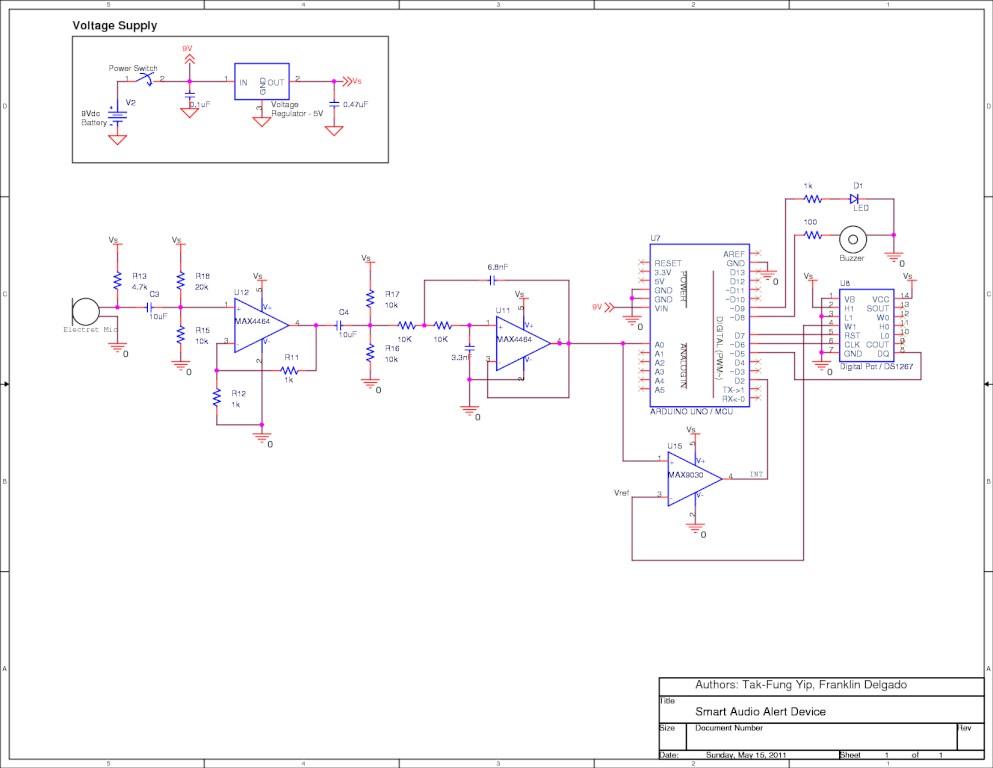
Small Discrete Audio Power Amplifier
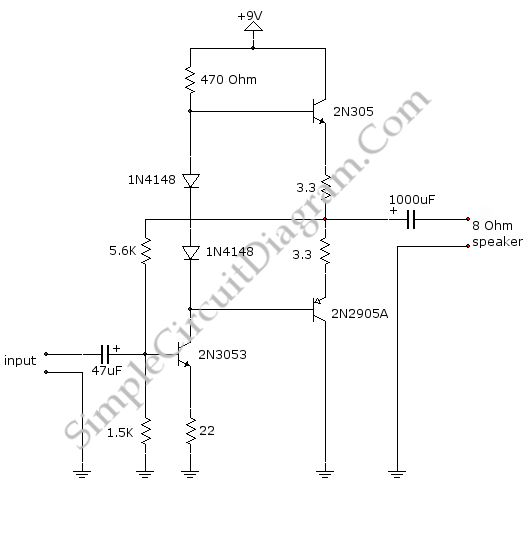
This is a small audio amplifier, similar to those used in small transistor radios. The circuit draws approximately 30 milliamps from a 9-volt supply and consists of two stages. The first stage is the input stage using a 2N3053 transistor, while the output stage comprises a pair of 2N3053 and 2N2905 transistors. The schematic diagram of the circuit shows that the supply voltage is divided equally across the two complementary output transistors, which are slightly biased into conduction by diodes connected between their bases due to the biasing of the input stage. To stabilize the bias current, which may vary with different transistors, diodes, or temperature, a 3.3-ohm resistor is placed in series with the emitters of the output transistors. This arrangement reduces the voltage between the base and emitter as the bias current increases, thereby limiting conduction. The circuit achieves a voltage gain of about 5 with an 8-ohm speaker attached and has an input impedance of approximately 500 ohms. The output stage provides a voltage swing of about 2 volts across the speaker without distortion, with the power output in the range of 50 milliwatts. To increase power output, heat sinks can be added to the output transistors, along with a higher supply voltage. Using an LM1875, a low-cost yet high-performance audio power amplifier can be constructed, capable of producing 20 watts of output power for 4 or 8-ohm speakers with a 50V power supply, and potentially 30 watts with a 60V supply. This audio power amplifier is suitable for portable devices or as a headphone amplifier. The circuit is straightforward, consisting of only seven components. The schematic diagram of the amplifier circuit illustrates that the transistor operates in class A biasing, meaning the collector current flows continuously, varying with the input signal that affects the forward bias.
The audio amplifier circuit described utilizes a two-stage configuration, which is effective for achieving both modest power output and sound quality. The first stage, employing the 2N3053 transistor, acts as a preamplifier, receiving the audio input signal and amplifying it to a level suitable for the output stage. The output stage, consisting of a complementary pair of transistors (2N3053 and 2N2905), is designed to drive the speaker directly. This arrangement not only enhances the overall efficiency of the amplifier but also ensures that the output signal remains linear, minimizing distortion.
The biasing method employed in this circuit is crucial for maintaining consistent performance across various operating conditions. The inclusion of diodes between the bases of the output transistors serves to establish a stable operating point, compensating for variations in temperature and component characteristics. The 3.3-ohm resistor in the emitter path is a negative feedback element that helps control the gain and linearity of the amplifier, ensuring that the output remains faithful to the input signal.
The voltage gain of around 5 is adequate for driving an 8-ohm speaker, making this amplifier suitable for applications where moderate sound levels are required without the need for excessive power. The output swing of approximately 2 volts across the speaker indicates that the amplifier can deliver sufficient audio levels for personal listening devices.
For applications requiring higher power output, the use of heat sinks on the output transistors is recommended to dissipate the heat generated during operation, particularly when higher supply voltages are employed. The LM1875 integrated circuit is a viable option for those looking to build a more powerful amplifier, providing significant output capabilities while maintaining simplicity in design.
Overall, this audio amplifier circuit exemplifies an effective solution for portable audio applications, balancing performance, size, and component count while delivering satisfactory sound quality.This is a little audio amplifier, it is similar to the audio amplifier which is used in small transistor radio. This circuit draws about 30 milliamps from a 9 volt supply. This circuit consist of two stage. First stage is input stage (2N3053 transistor) and the other is output stage (2N3053 and 2N2905 transistor pair).
Here is the schematic diagra m of the circuit : Supply voltage is divided equally across the two complimentary output transistors which are slightly biased in conduction by the diodes between the bases because the input stage is biased. To stabilize the bias current so it doesn`t change much with different transistors and diodes or with temperature.
This circuit uses a 3. 3 ohm resistor that assembled in series with the emitters of the output transistors. The voltage between the base and emitter decreased, because the bias current increased, so it is reduce the conduction. This circuit has voltage gain about 5 with an 8 ohm speaker attached and input impedance about 500 ohms.
In the output stage, the voltage swing on the speaker is about 2 volts without distorting. The power output of this circuit is in the 50 milliwatt range. To provide more power we must use the addition of heat sinks to the output transistors and a higher supply voltage. With LM1875, we can build a low cost but high performance audio power amplifier. With 50V power supply, it can produce 20W output power for 4 or 8 ohm speaker. We can even get 30W output if we use 60V Continue reading †’. This audio power amplifier is very good for your portable devices, or for your headphones amplifier. The circuit of this audio power amplifier is very simple, consist of only seven components. Here is the schematic diagram of the amplifier circuit: Continue reading †’. The transistor is biased in class A. That`s mean the collector current flows all the time. This current can increase or decrease, caused by the input signal which increases and decreases the forward bias.
This increasing or decreasing depends on Continue reading †’. The basis of an audio mixer is an inverting summing circuit below. For real audio mixers, a single-supply voltage is seldom used. To increase dynamic range, the designer will often push an op amp up to, and sometimes beyond it`s Continue reading †’. We can also operate TDA8932B/33(B) from a symmetrical supply. On this diagram, three half supply voltage buffers are disabled. When supplied from a symmetrical supply, HVPREF (Pin 11), HVP1 (pin 30) and HVP2 (Pin 19) should be connected to ground.
Continue reading †’. 🔗 External reference
The audio amplifier circuit described utilizes a two-stage configuration, which is effective for achieving both modest power output and sound quality. The first stage, employing the 2N3053 transistor, acts as a preamplifier, receiving the audio input signal and amplifying it to a level suitable for the output stage. The output stage, consisting of a complementary pair of transistors (2N3053 and 2N2905), is designed to drive the speaker directly. This arrangement not only enhances the overall efficiency of the amplifier but also ensures that the output signal remains linear, minimizing distortion.
The biasing method employed in this circuit is crucial for maintaining consistent performance across various operating conditions. The inclusion of diodes between the bases of the output transistors serves to establish a stable operating point, compensating for variations in temperature and component characteristics. The 3.3-ohm resistor in the emitter path is a negative feedback element that helps control the gain and linearity of the amplifier, ensuring that the output remains faithful to the input signal.
The voltage gain of around 5 is adequate for driving an 8-ohm speaker, making this amplifier suitable for applications where moderate sound levels are required without the need for excessive power. The output swing of approximately 2 volts across the speaker indicates that the amplifier can deliver sufficient audio levels for personal listening devices.
For applications requiring higher power output, the use of heat sinks on the output transistors is recommended to dissipate the heat generated during operation, particularly when higher supply voltages are employed. The LM1875 integrated circuit is a viable option for those looking to build a more powerful amplifier, providing significant output capabilities while maintaining simplicity in design.
Overall, this audio amplifier circuit exemplifies an effective solution for portable audio applications, balancing performance, size, and component count while delivering satisfactory sound quality.This is a little audio amplifier, it is similar to the audio amplifier which is used in small transistor radio. This circuit draws about 30 milliamps from a 9 volt supply. This circuit consist of two stage. First stage is input stage (2N3053 transistor) and the other is output stage (2N3053 and 2N2905 transistor pair).
Here is the schematic diagra m of the circuit : Supply voltage is divided equally across the two complimentary output transistors which are slightly biased in conduction by the diodes between the bases because the input stage is biased. To stabilize the bias current so it doesn`t change much with different transistors and diodes or with temperature.
This circuit uses a 3. 3 ohm resistor that assembled in series with the emitters of the output transistors. The voltage between the base and emitter decreased, because the bias current increased, so it is reduce the conduction. This circuit has voltage gain about 5 with an 8 ohm speaker attached and input impedance about 500 ohms.
In the output stage, the voltage swing on the speaker is about 2 volts without distorting. The power output of this circuit is in the 50 milliwatt range. To provide more power we must use the addition of heat sinks to the output transistors and a higher supply voltage. With LM1875, we can build a low cost but high performance audio power amplifier. With 50V power supply, it can produce 20W output power for 4 or 8 ohm speaker. We can even get 30W output if we use 60V Continue reading †’. This audio power amplifier is very good for your portable devices, or for your headphones amplifier. The circuit of this audio power amplifier is very simple, consist of only seven components. Here is the schematic diagram of the amplifier circuit: Continue reading †’. The transistor is biased in class A. That`s mean the collector current flows all the time. This current can increase or decrease, caused by the input signal which increases and decreases the forward bias.
This increasing or decreasing depends on Continue reading †’. The basis of an audio mixer is an inverting summing circuit below. For real audio mixers, a single-supply voltage is seldom used. To increase dynamic range, the designer will often push an op amp up to, and sometimes beyond it`s Continue reading †’. We can also operate TDA8932B/33(B) from a symmetrical supply. On this diagram, three half supply voltage buffers are disabled. When supplied from a symmetrical supply, HVPREF (Pin 11), HVP1 (pin 30) and HVP2 (Pin 19) should be connected to ground.
Continue reading †’. 🔗 External reference
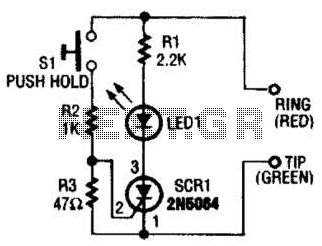
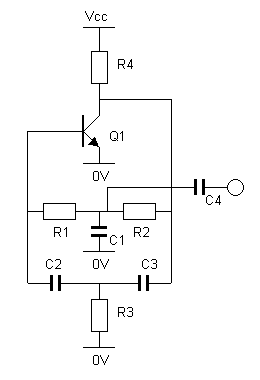
.gif)
